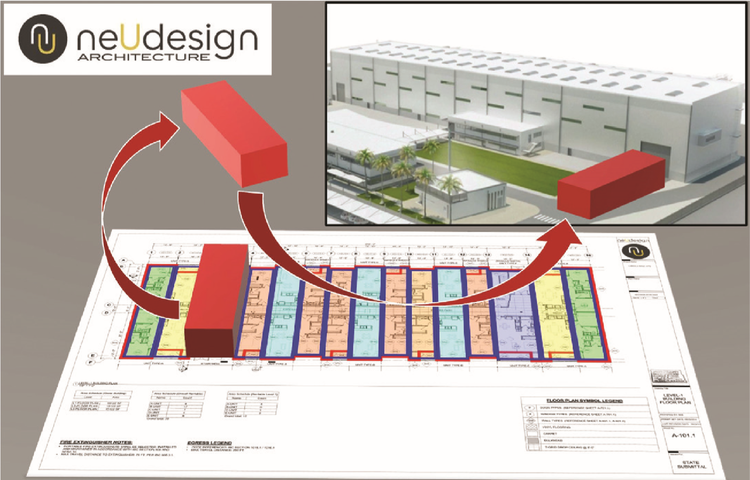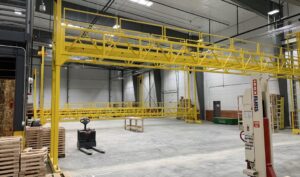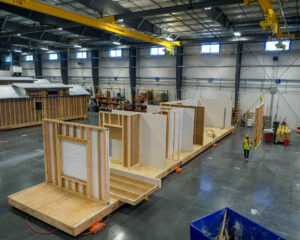As modular construction continues to gain momentum in North America, many developers and owners are starting to look into their first modular project. Ensuring success on the first build often starts with good design. Here are a few other tips to consider when designing a modular building.
Focus on these three key elements from the start:
- Select and Hire the Right Team: Either hire an experienced Modular Design Team (Architect, Structural Engineer, MEP) or have an in-house design team that is supported by an experienced Modular Design Team
- Sweat the Details: LOD, BIM, DfMA
- Implementing the Modular Mindset
1. Select an experienced modular design team.
Hire an experienced modular design firm. To evaluate a design firms’ capabilities, focus on key requirements needed to manage a modular project:
-
Modular design experience
-
Factory manufacturing experience (Actual factory design team experience)
-
Manufacturing process and sequencing experience
-
Willingness to document Means and Methods within design documents
-
Typically Means and Methods are not addressed within traditional design packages but are required throughout Modular Design to establish intent and compliance with traditional building codes and assemblies. As of today, there is no Modular International Building Code or prescriptive assemblies geared toward the unique assemblies within Modular Construction, so frequently Means and Methods need to be exemplified within the design documents.
-
-
Offsite Permitting and Inspections associated with the Modular Construction process
-
It’s common that the design team not only has to manage the process, but they are responsible for educating the jurisdiction on the scope delineation and review process as well. These requirements need to be summarized in a clear scope of work and a list of deliverables needs to be created to ensure that the items are being addressed throughout the design phases.
-
 Consider a hybrid team
Consider a hybrid team
That said, many developers and GC’s have strong ties with design professionals and may want to continue that relationship. Many of the predesign, entitlements, and design review processes can be handled by the current design team with an experienced Modular Design Team being engaged at the Design Development phase.
While many traditional design teams embrace the concept of modular design, but they often struggle with the implementation phase. This “gap” occurs within the design coordination phase (LOD 350) when the building model is fully vetted to address MEP Coordination & Clash Detection, Structural Sequencing and Assembly, Module Variable Analysis, and so on.
An experienced Modular Design Team should be able to provide a clear list of deliverables and scope analysis to complete this phase. By approaching a project with a split scope, the hybrid team can maximize the value of each design consultant while minimizing the potential rework or post-design changes in preparation for the manufacturing process. Teams should use a Responsibility Matrix that clearly defines the roles and responsibilities for each team member involved throughout the entire scope of the project.
This hybrid team could be several firms working together or a single firm with specialized teams in-house.
2. Sweat the Details: LOD, BIM, DfMA
Design for Manufacture and Assembly (DfMA) The shift from Unit Types to Module Types mirrors the shift in the construction industry to DfMA. DfMA makes perfect sense to the contractors, but it represents a sea of change in the mindset of many designers. Rather than designing for a specific milestone, the team must design with the fabrication process in mind. Understanding how the components are assembled, sequenced, and fabricated is critical to designing a building for the modular construction process. Having knowledge of the benefits and constraints of the manufacturer is essential from the first stage of design to the last to avoid rework of design, delays in manufacturing, and additional costs.
Leverage your Building Information Model (BIM)
BIM technology allows the team to add the components and layouts to your model in the early stages of design. These critical details will act as a template throughout the process and flow directly into the factory construction workflow for shop drawings and manufacturing. DfMA is an intentional process to ensure that the building is designed for the factory protocols.
Model Development also helps shift the understanding of the building from “Unit Type” development to “Module Type” development, which is how the factory builds. By placing a focus on Module Types, the team is conscious of their efforts to reduce the number of unique module types. The focus is then on re-use and repetition throughout the building to maximize the efficiencies of offsite construction.
 Level of Development (LOD) vs Traditional Design Phases
Level of Development (LOD) vs Traditional Design Phases
Focusing on the BIM LOD rather than the traditional design phases is important and allows the team to speak a universal language specific to the Model Development.
This is a critical component to ensure the proper steps are being implemented throughout the Design Phases to prepare for Factory Construction. The Traditional Design Process involves Schematic Design, Design Development, and Construction Documents (Permit Submittal Docs). While these Traditional Design Phases outline a process and deliverables, they aren’t adequate to identify the BIM Level of Development (LOD) associated with each phase. To take things a step further, the team needs to define the BIM Level of Development. This is referred to as the LOD Structure and associated examples to ensure the team is clearly defining the LOD 100 – 400 for each phase.
3. Implementing the Modular Mindset
Modular Construction involves a significant amount of coordination and integration not only upfront, but throughout the entire design, fabrication, and construction phases. By applying the key elements shared in this article, a team can bridge any scope gaps that arise on projects by partnering with an experienced and knowledgeable team throughout the entire process.
With a modular project, designers must recognize that their role has new and varying degrees of responsibilities that go far beyond those traditionally assumed by the architect. Incorporating a hybrid team solution with a modular design professional ensures that the values and benefits associated with Modular Construction are achieved on a consistent basis. By establishing the right team from the beginning and implementing a modular mindset any offsite construction build can be successful.










